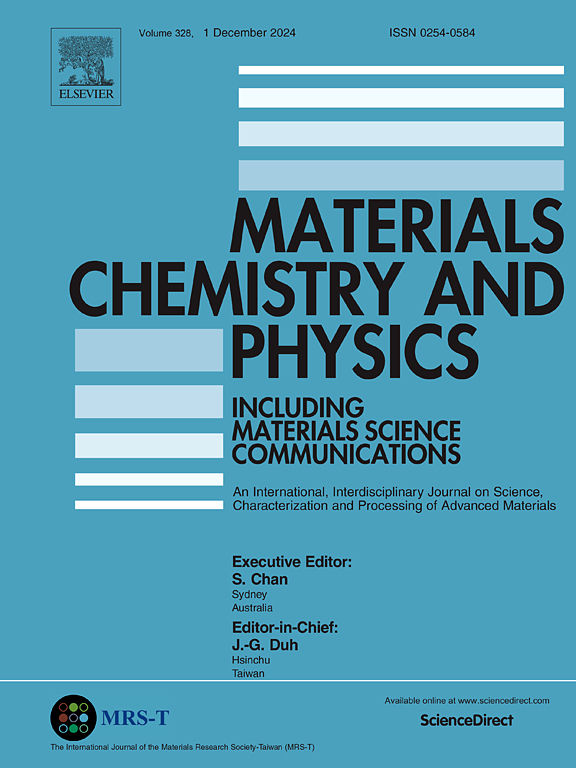A novel ethylenediamine-bridged cobalt (II) phthalocyanine decorated MWCNT for advanced electrochemical sensing of acetaminophen
IF 4.7
3区 材料科学
Q2 MATERIALS SCIENCE, MULTIDISCIPLINARY
引用次数: 0
Abstract
The design and synthesis of effective molecular catalysts are essential for the efficient electrochemical sensing of pollutants. Due to their adjustable peripheral site, cobalt phthalocyanines (CoPc) are well-known electrochemical sensors for various organic, inorganic, and biomolecular analytes. In this study, multi-walled carbon nanotubes (MWCNT) were anchored onto ethylenediamine-bridged cobalt (II) phthalocyanine (EACoPc) to form EACoPc-MWCNT in three different ratios (1:1, 1:2, and 1:5 for EACoPc and MWCNT taken). The redox-active Cobalt metal in the central cavity of the highly conjugated phthalocyanine complex and the large surface area of MWCNT facilitate the electrochemical detection of analytes in water. The structural, physical, and morphological properties of the newly developed composites were investigated using various analytical techniques. The three composites were then drop-cast onto a glassy carbon electrode (GCE) to detect acetaminophen (AC) using cyclic voltammetry (CV) and Differential Pulse Voltammetry (DPV). Among the three composites, the EACoPc-MWCNT 1:2-modified GCE was found to have the highest activity toward the AC over a linear concentration range of 10–100 μM, with a detection limit of 2.14 μM using phosphate buffer as an electrolyte. From chronoamperometric analysis, the response time of the modified electrode was found to be 3 s for 25 μM of AC. The developed electrode depicted remarkable stability and reproducibility. Under optimum conditions, the modified sensor could recognise AC from other interferents. The practical applicability of the analytically modified sensor was analyzed in real water samples using the spiking method and showed impressive recovery rates of >97 %.

一种新型乙二胺桥接钴(II)酞菁修饰的纳米碳纳米管用于对乙酰氨基酚的高级电化学传感
设计和合成有效的分子催化剂是实现污染物电化学传感的关键。由于其可调节的外周位置,酞菁钴(CoPc)是各种有机,无机和生物分子分析物的众所周知的电化学传感器。在这项研究中,将多壁碳纳米管(MWCNT)固定在乙二胺桥接的钴(II)酞菁(EACoPc)上,以三种不同的比例(EACoPc和MWCNT分别为1:1、1:2和1:5)形成EACoPc-MWCNT。高共轭酞菁配合物中心腔中的氧化还原活性钴金属和MWCNT的大表面积有利于水中分析物的电化学检测。利用各种分析技术对新开发的复合材料的结构、物理和形态性能进行了研究。然后将这三种复合材料滴铸到玻碳电极(GCE)上,使用循环伏安法(CV)和差分脉冲伏安法(DPV)检测对乙酰氨基酚(AC)。在10 ~ 100 μM的线性浓度范围内,EACoPc-MWCNT 1:2改性GCE对AC的检测活性最高,以磷酸盐缓冲液为电解质时,检测限为2.14 μM。实验结果表明,该电极在25 μM AC下的响应时间为3 s,具有良好的稳定性和重复性。在最佳条件下,改进后的传感器可以识别来自其他干扰的交流信号。在实际水样中使用峰值法分析了分析改进传感器的实用性,并显示了令人印象深刻的回收率>; 97%。
本文章由计算机程序翻译,如有差异,请以英文原文为准。
求助全文
约1分钟内获得全文
求助全文
来源期刊

Materials Chemistry and Physics
工程技术-材料科学:综合
CiteScore
8.70
自引率
4.30%
发文量
1515
审稿时长
69 days
期刊介绍:
Materials Chemistry and Physics is devoted to short communications, full-length research papers and feature articles on interrelationships among structure, properties, processing and performance of materials. The Editors welcome manuscripts on thin films, surface and interface science, materials degradation and reliability, metallurgy, semiconductors and optoelectronic materials, fine ceramics, magnetics, superconductors, specialty polymers, nano-materials and composite materials.
 求助内容:
求助内容: 应助结果提醒方式:
应助结果提醒方式:


